Human Resource Management Report: British Airways Performance Analysis
VerifiedAdded on 2020/10/05
|13
|2750
|249
Report
AI Summary
This report provides an in-depth analysis of British Airways' Human Resource Management (HRM) practices. It examines the learning and development strategies employed to enhance employee skills, including professional training, coaching, and cross-departmental training, as well as the development of soft skills. The report also explores the performance management system, its usage, purpose, procedures, and its role in supporting employee performance. Furthermore, it highlights the links between performance management and learning and development initiatives, emphasizing their combined impact on employee growth. The report also discusses the key regulations impacting the airline industry, such as deregulation and employment safety laws, and compares local legislation to UK law, identifying similarities in legal frameworks like employment contracts and data protection. The report concludes by summarizing the key findings and their implications for British Airways.
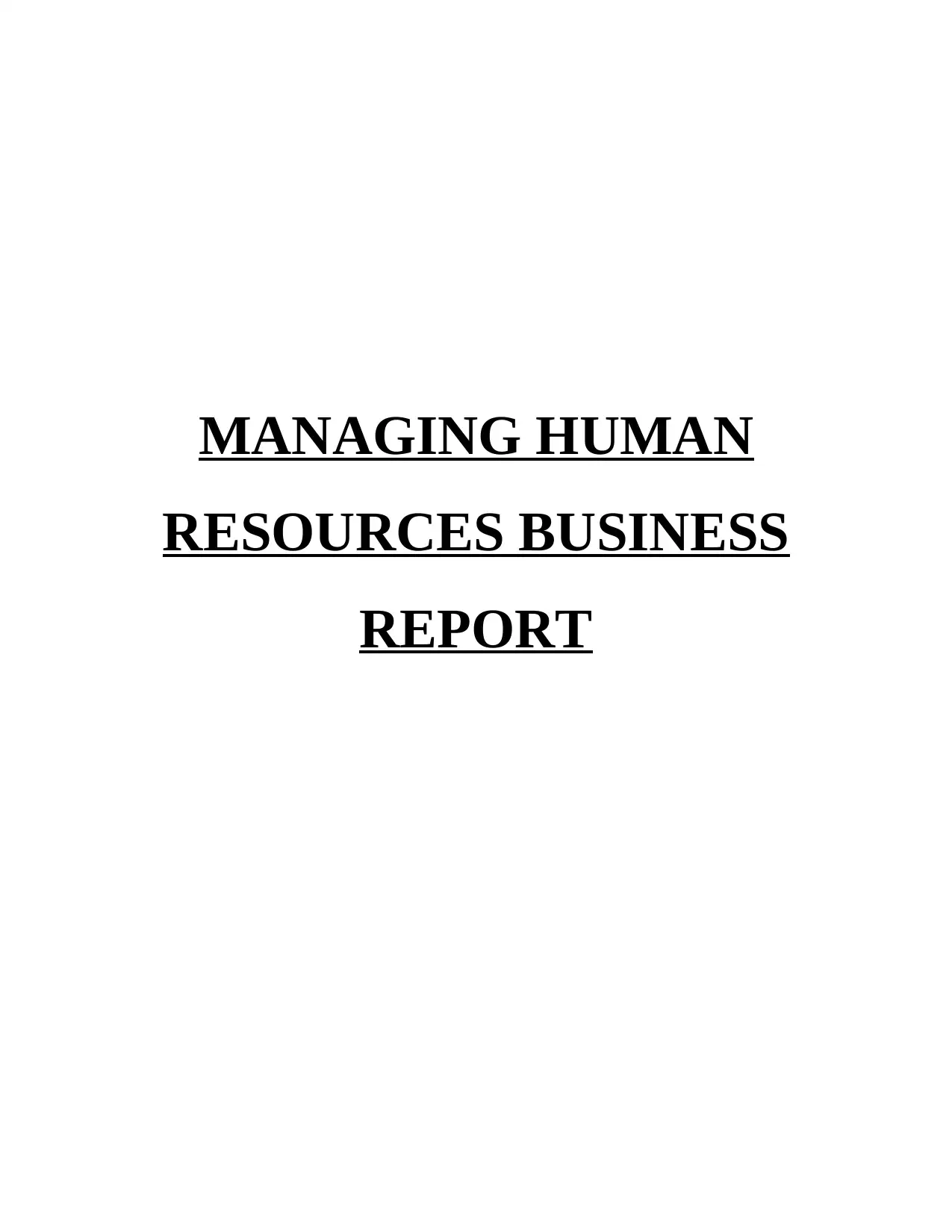
MANAGING HUMAN
RESOURCES BUSINESS
REPORT
RESOURCES BUSINESS
REPORT
Paraphrase This Document
Need a fresh take? Get an instant paraphrase of this document with our AI Paraphraser
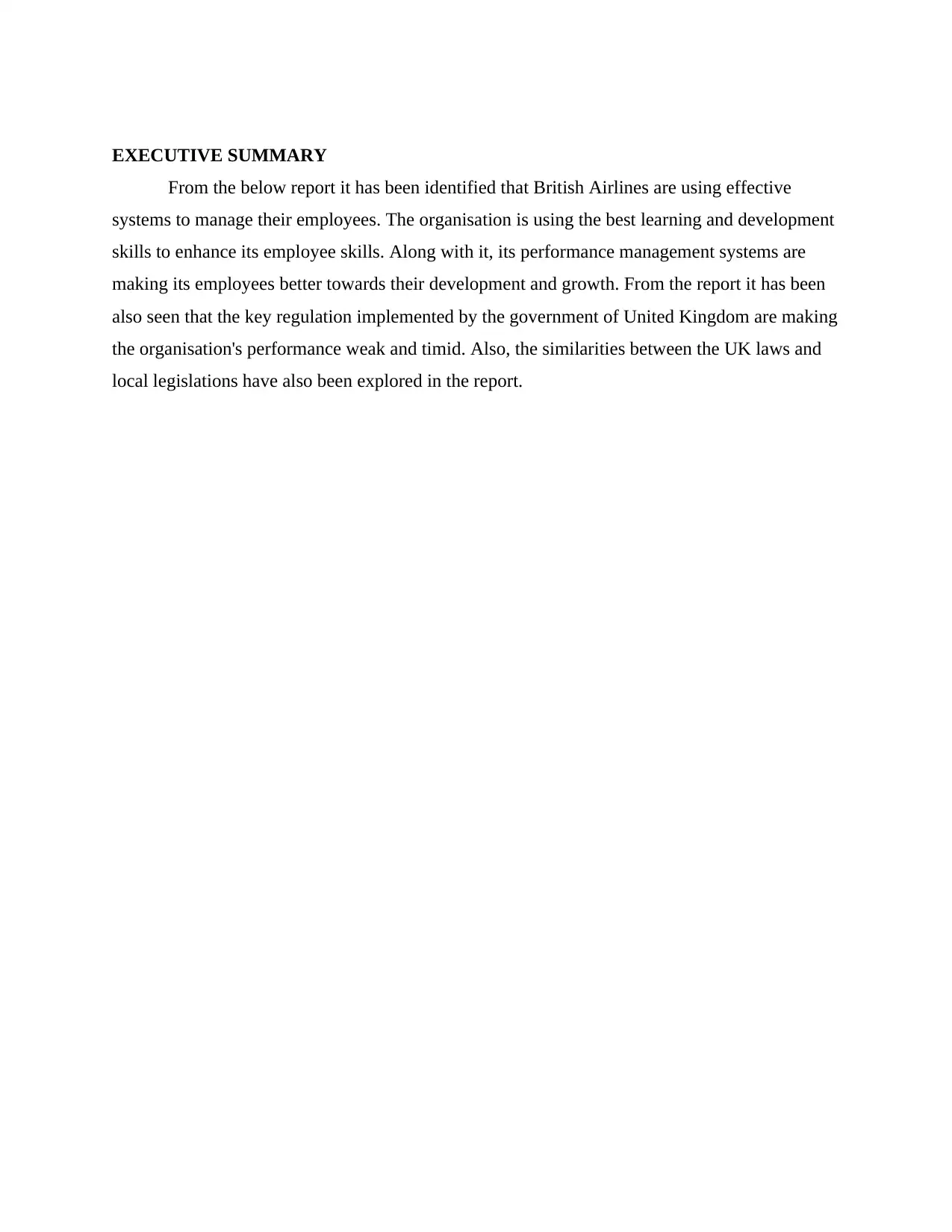
EXECUTIVE SUMMARY
From the below report it has been identified that British Airlines are using effective
systems to manage their employees. The organisation is using the best learning and development
skills to enhance its employee skills. Along with it, its performance management systems are
making its employees better towards their development and growth. From the report it has been
also seen that the key regulation implemented by the government of United Kingdom are making
the organisation's performance weak and timid. Also, the similarities between the UK laws and
local legislations have also been explored in the report.
From the below report it has been identified that British Airlines are using effective
systems to manage their employees. The organisation is using the best learning and development
skills to enhance its employee skills. Along with it, its performance management systems are
making its employees better towards their development and growth. From the report it has been
also seen that the key regulation implemented by the government of United Kingdom are making
the organisation's performance weak and timid. Also, the similarities between the UK laws and
local legislations have also been explored in the report.
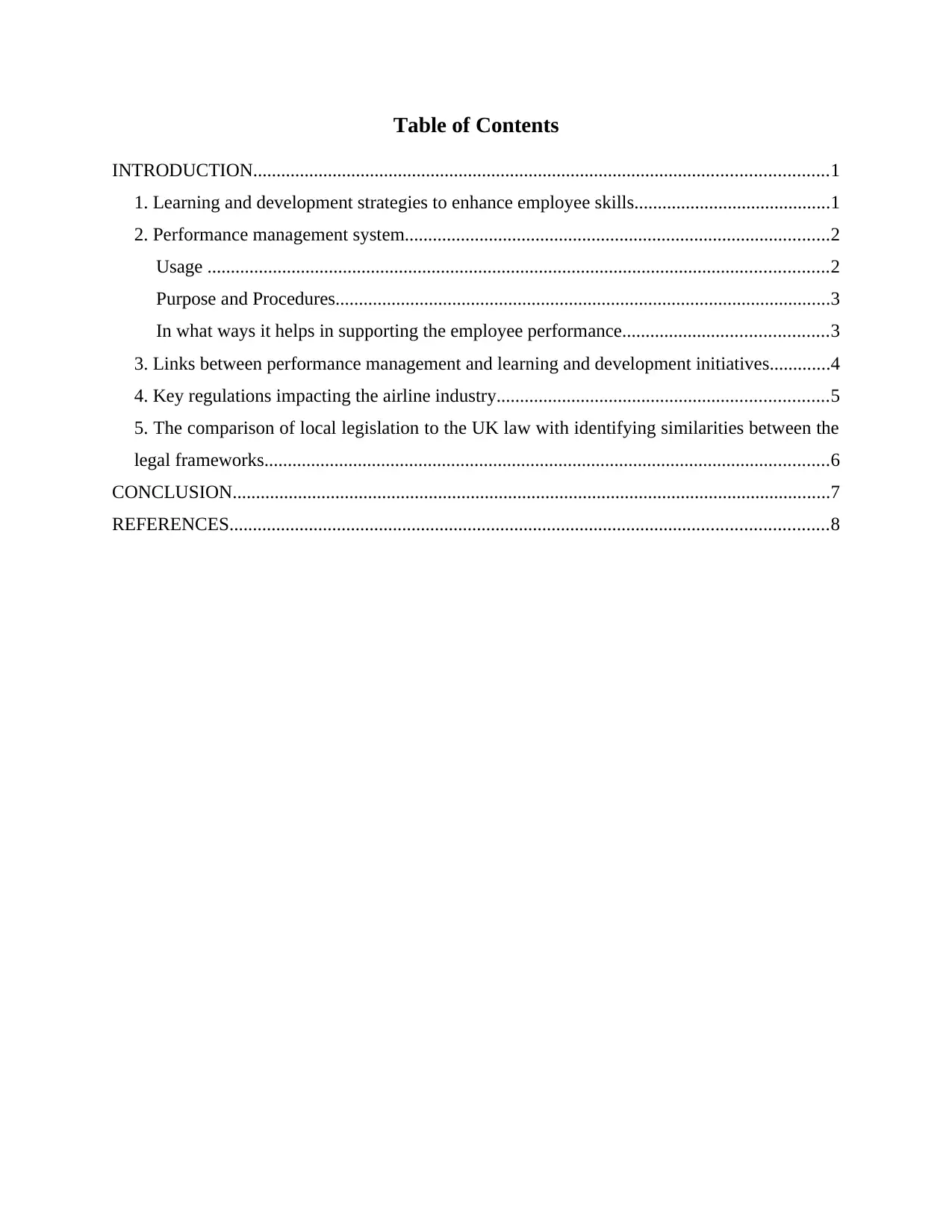
Table of Contents
INTRODUCTION...........................................................................................................................1
1. Learning and development strategies to enhance employee skills..........................................1
2. Performance management system...........................................................................................2
Usage .....................................................................................................................................2
Purpose and Procedures..........................................................................................................3
In what ways it helps in supporting the employee performance............................................3
3. Links between performance management and learning and development initiatives.............4
4. Key regulations impacting the airline industry.......................................................................5
5. The comparison of local legislation to the UK law with identifying similarities between the
legal frameworks.........................................................................................................................6
CONCLUSION................................................................................................................................7
REFERENCES................................................................................................................................8
INTRODUCTION...........................................................................................................................1
1. Learning and development strategies to enhance employee skills..........................................1
2. Performance management system...........................................................................................2
Usage .....................................................................................................................................2
Purpose and Procedures..........................................................................................................3
In what ways it helps in supporting the employee performance............................................3
3. Links between performance management and learning and development initiatives.............4
4. Key regulations impacting the airline industry.......................................................................5
5. The comparison of local legislation to the UK law with identifying similarities between the
legal frameworks.........................................................................................................................6
CONCLUSION................................................................................................................................7
REFERENCES................................................................................................................................8
⊘ This is a preview!⊘
Do you want full access?
Subscribe today to unlock all pages.

Trusted by 1+ million students worldwide

Paraphrase This Document
Need a fresh take? Get an instant paraphrase of this document with our AI Paraphraser
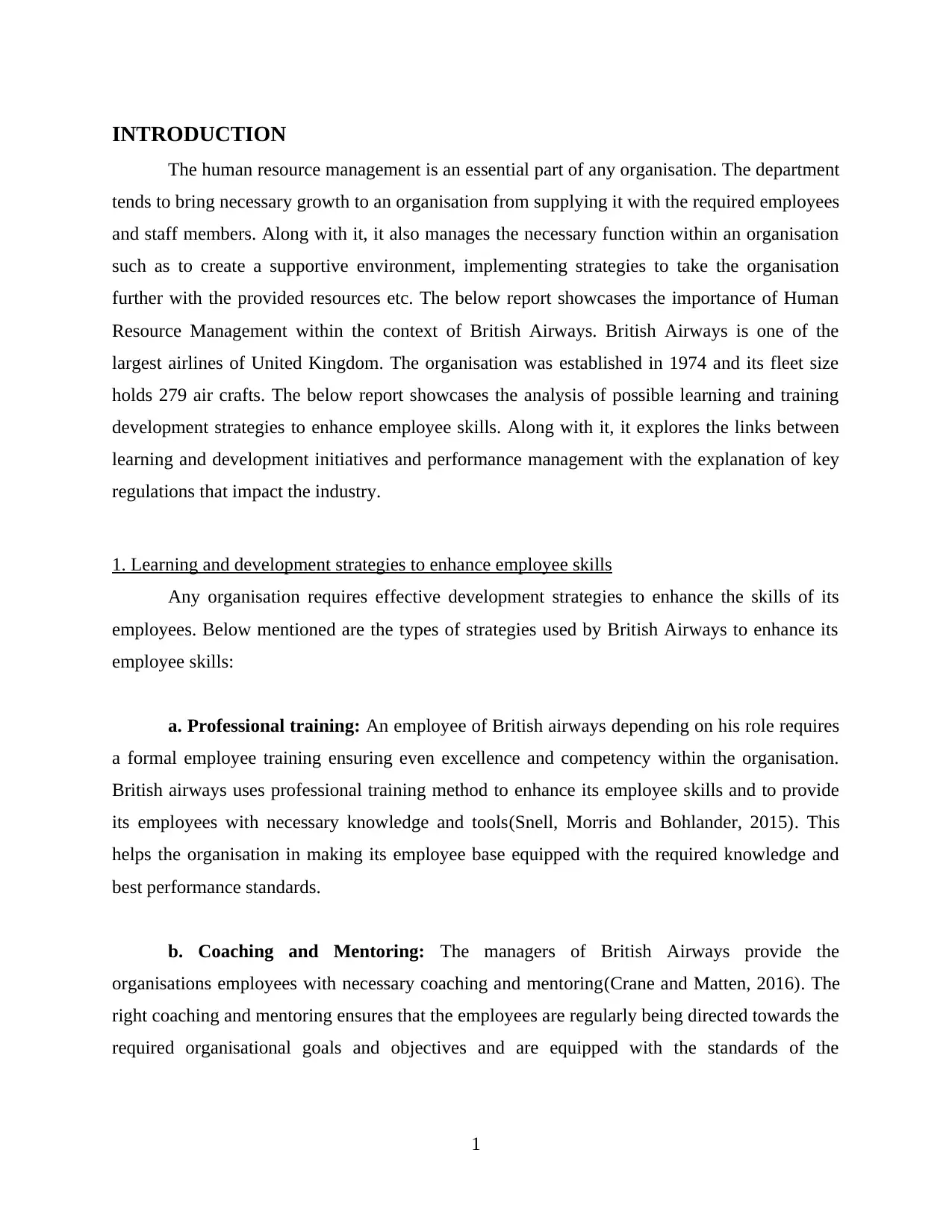
INTRODUCTION
The human resource management is an essential part of any organisation. The department
tends to bring necessary growth to an organisation from supplying it with the required employees
and staff members. Along with it, it also manages the necessary function within an organisation
such as to create a supportive environment, implementing strategies to take the organisation
further with the provided resources etc. The below report showcases the importance of Human
Resource Management within the context of British Airways. British Airways is one of the
largest airlines of United Kingdom. The organisation was established in 1974 and its fleet size
holds 279 air crafts. The below report showcases the analysis of possible learning and training
development strategies to enhance employee skills. Along with it, it explores the links between
learning and development initiatives and performance management with the explanation of key
regulations that impact the industry.
1. Learning and development strategies to enhance employee skills
Any organisation requires effective development strategies to enhance the skills of its
employees. Below mentioned are the types of strategies used by British Airways to enhance its
employee skills:
a. Professional training: An employee of British airways depending on his role requires
a formal employee training ensuring even excellence and competency within the organisation.
British airways uses professional training method to enhance its employee skills and to provide
its employees with necessary knowledge and tools(Snell, Morris and Bohlander, 2015). This
helps the organisation in making its employee base equipped with the required knowledge and
best performance standards.
b. Coaching and Mentoring: The managers of British Airways provide the
organisations employees with necessary coaching and mentoring(Crane and Matten, 2016). The
right coaching and mentoring ensures that the employees are regularly being directed towards the
required organisational goals and objectives and are equipped with the standards of the
1
The human resource management is an essential part of any organisation. The department
tends to bring necessary growth to an organisation from supplying it with the required employees
and staff members. Along with it, it also manages the necessary function within an organisation
such as to create a supportive environment, implementing strategies to take the organisation
further with the provided resources etc. The below report showcases the importance of Human
Resource Management within the context of British Airways. British Airways is one of the
largest airlines of United Kingdom. The organisation was established in 1974 and its fleet size
holds 279 air crafts. The below report showcases the analysis of possible learning and training
development strategies to enhance employee skills. Along with it, it explores the links between
learning and development initiatives and performance management with the explanation of key
regulations that impact the industry.
1. Learning and development strategies to enhance employee skills
Any organisation requires effective development strategies to enhance the skills of its
employees. Below mentioned are the types of strategies used by British Airways to enhance its
employee skills:
a. Professional training: An employee of British airways depending on his role requires
a formal employee training ensuring even excellence and competency within the organisation.
British airways uses professional training method to enhance its employee skills and to provide
its employees with necessary knowledge and tools(Snell, Morris and Bohlander, 2015). This
helps the organisation in making its employee base equipped with the required knowledge and
best performance standards.
b. Coaching and Mentoring: The managers of British Airways provide the
organisations employees with necessary coaching and mentoring(Crane and Matten, 2016). The
right coaching and mentoring ensures that the employees are regularly being directed towards the
required organisational goals and objectives and are equipped with the standards of the
1
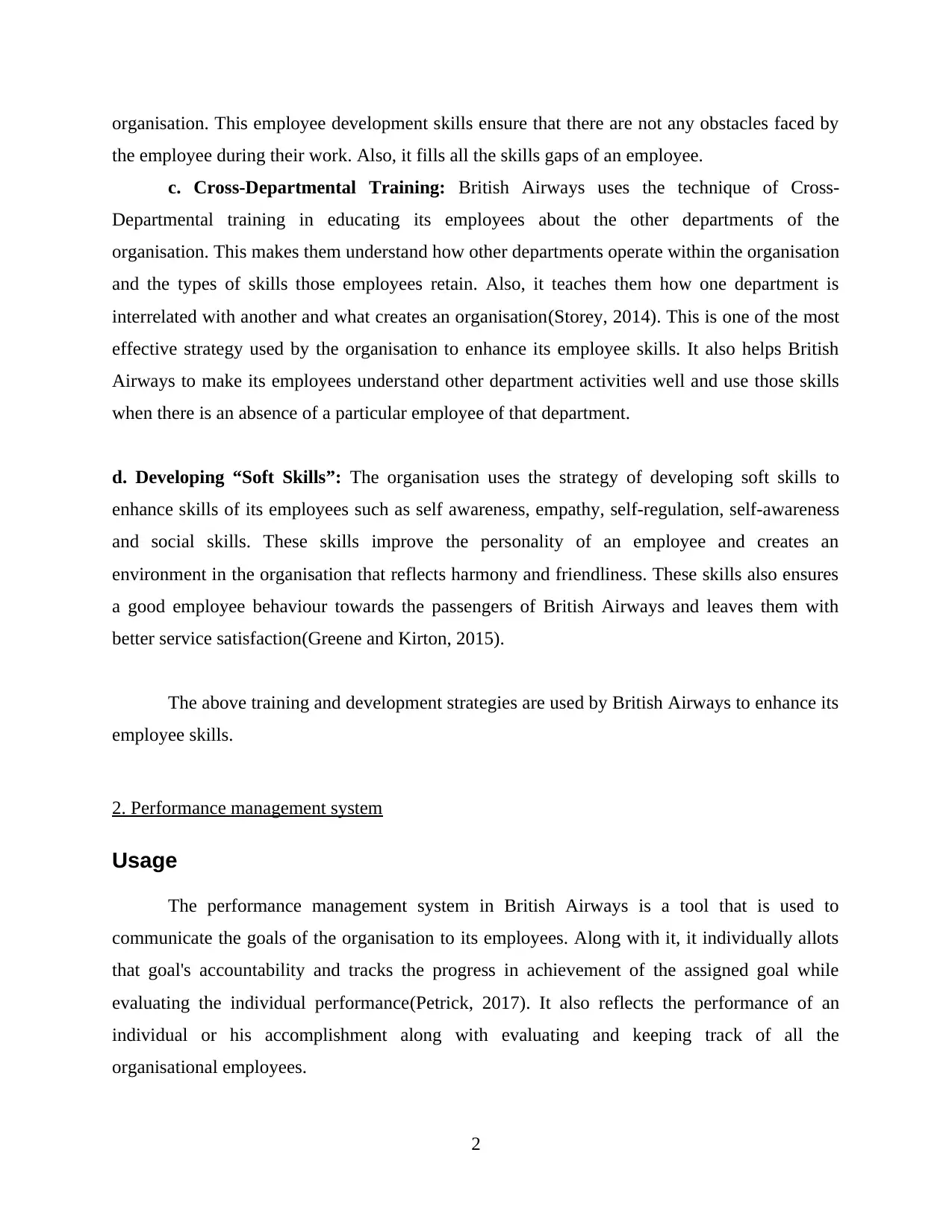
organisation. This employee development skills ensure that there are not any obstacles faced by
the employee during their work. Also, it fills all the skills gaps of an employee.
c. Cross-Departmental Training: British Airways uses the technique of Cross-
Departmental training in educating its employees about the other departments of the
organisation. This makes them understand how other departments operate within the organisation
and the types of skills those employees retain. Also, it teaches them how one department is
interrelated with another and what creates an organisation(Storey, 2014). This is one of the most
effective strategy used by the organisation to enhance its employee skills. It also helps British
Airways to make its employees understand other department activities well and use those skills
when there is an absence of a particular employee of that department.
d. Developing “Soft Skills”: The organisation uses the strategy of developing soft skills to
enhance skills of its employees such as self awareness, empathy, self-regulation, self-awareness
and social skills. These skills improve the personality of an employee and creates an
environment in the organisation that reflects harmony and friendliness. These skills also ensures
a good employee behaviour towards the passengers of British Airways and leaves them with
better service satisfaction(Greene and Kirton, 2015).
The above training and development strategies are used by British Airways to enhance its
employee skills.
2. Performance management system
Usage
The performance management system in British Airways is a tool that is used to
communicate the goals of the organisation to its employees. Along with it, it individually allots
that goal's accountability and tracks the progress in achievement of the assigned goal while
evaluating the individual performance(Petrick, 2017). It also reflects the performance of an
individual or his accomplishment along with evaluating and keeping track of all the
organisational employees.
2
the employee during their work. Also, it fills all the skills gaps of an employee.
c. Cross-Departmental Training: British Airways uses the technique of Cross-
Departmental training in educating its employees about the other departments of the
organisation. This makes them understand how other departments operate within the organisation
and the types of skills those employees retain. Also, it teaches them how one department is
interrelated with another and what creates an organisation(Storey, 2014). This is one of the most
effective strategy used by the organisation to enhance its employee skills. It also helps British
Airways to make its employees understand other department activities well and use those skills
when there is an absence of a particular employee of that department.
d. Developing “Soft Skills”: The organisation uses the strategy of developing soft skills to
enhance skills of its employees such as self awareness, empathy, self-regulation, self-awareness
and social skills. These skills improve the personality of an employee and creates an
environment in the organisation that reflects harmony and friendliness. These skills also ensures
a good employee behaviour towards the passengers of British Airways and leaves them with
better service satisfaction(Greene and Kirton, 2015).
The above training and development strategies are used by British Airways to enhance its
employee skills.
2. Performance management system
Usage
The performance management system in British Airways is a tool that is used to
communicate the goals of the organisation to its employees. Along with it, it individually allots
that goal's accountability and tracks the progress in achievement of the assigned goal while
evaluating the individual performance(Petrick, 2017). It also reflects the performance of an
individual or his accomplishment along with evaluating and keeping track of all the
organisational employees.
2
⊘ This is a preview!⊘
Do you want full access?
Subscribe today to unlock all pages.

Trusted by 1+ million students worldwide
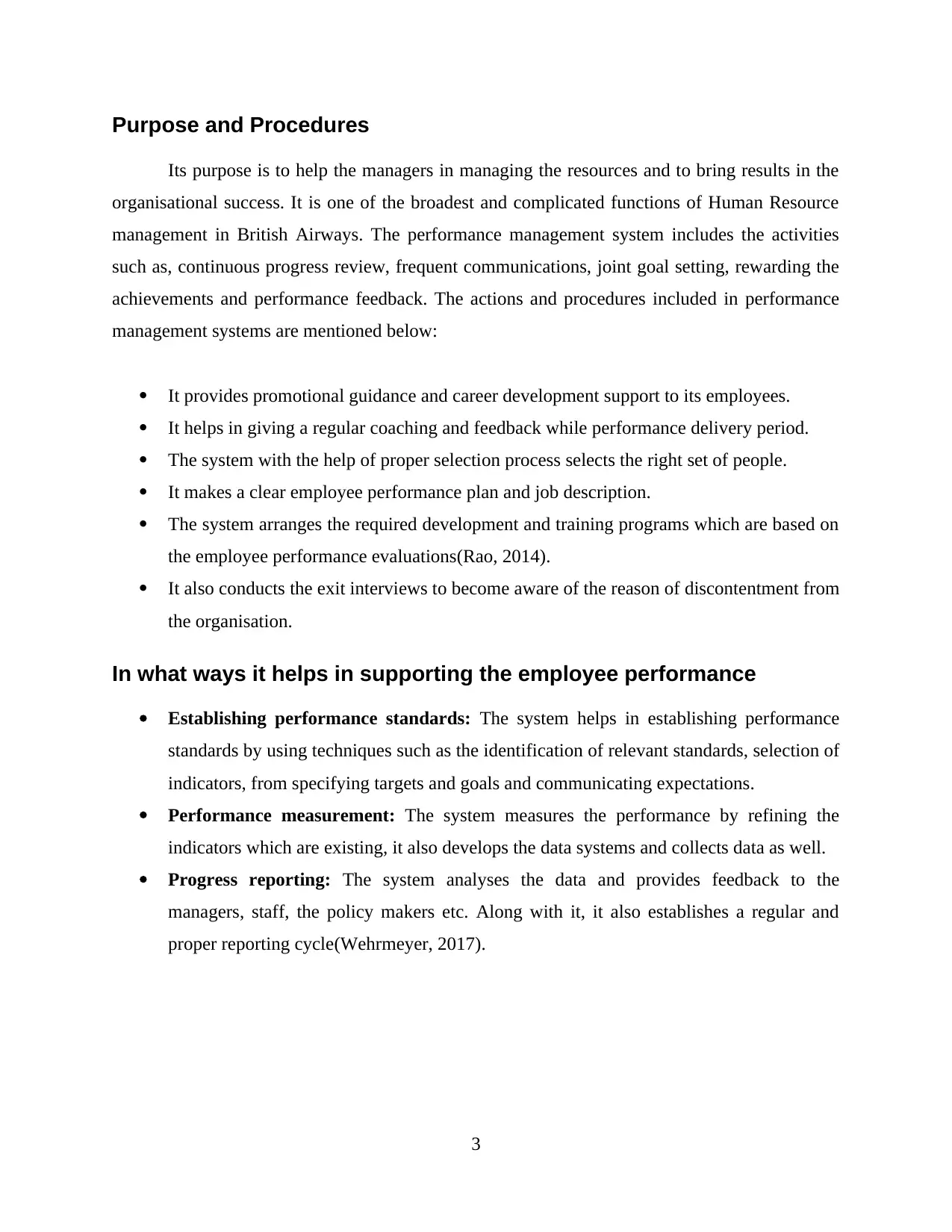
Purpose and Procedures
Its purpose is to help the managers in managing the resources and to bring results in the
organisational success. It is one of the broadest and complicated functions of Human Resource
management in British Airways. The performance management system includes the activities
such as, continuous progress review, frequent communications, joint goal setting, rewarding the
achievements and performance feedback. The actions and procedures included in performance
management systems are mentioned below:
It provides promotional guidance and career development support to its employees.
It helps in giving a regular coaching and feedback while performance delivery period.
The system with the help of proper selection process selects the right set of people.
It makes a clear employee performance plan and job description.
The system arranges the required development and training programs which are based on
the employee performance evaluations(Rao, 2014).
It also conducts the exit interviews to become aware of the reason of discontentment from
the organisation.
In what ways it helps in supporting the employee performance
Establishing performance standards: The system helps in establishing performance
standards by using techniques such as the identification of relevant standards, selection of
indicators, from specifying targets and goals and communicating expectations.
Performance measurement: The system measures the performance by refining the
indicators which are existing, it also develops the data systems and collects data as well.
Progress reporting: The system analyses the data and provides feedback to the
managers, staff, the policy makers etc. Along with it, it also establishes a regular and
proper reporting cycle(Wehrmeyer, 2017).
3
Its purpose is to help the managers in managing the resources and to bring results in the
organisational success. It is one of the broadest and complicated functions of Human Resource
management in British Airways. The performance management system includes the activities
such as, continuous progress review, frequent communications, joint goal setting, rewarding the
achievements and performance feedback. The actions and procedures included in performance
management systems are mentioned below:
It provides promotional guidance and career development support to its employees.
It helps in giving a regular coaching and feedback while performance delivery period.
The system with the help of proper selection process selects the right set of people.
It makes a clear employee performance plan and job description.
The system arranges the required development and training programs which are based on
the employee performance evaluations(Rao, 2014).
It also conducts the exit interviews to become aware of the reason of discontentment from
the organisation.
In what ways it helps in supporting the employee performance
Establishing performance standards: The system helps in establishing performance
standards by using techniques such as the identification of relevant standards, selection of
indicators, from specifying targets and goals and communicating expectations.
Performance measurement: The system measures the performance by refining the
indicators which are existing, it also develops the data systems and collects data as well.
Progress reporting: The system analyses the data and provides feedback to the
managers, staff, the policy makers etc. Along with it, it also establishes a regular and
proper reporting cycle(Wehrmeyer, 2017).
3
Paraphrase This Document
Need a fresh take? Get an instant paraphrase of this document with our AI Paraphraser
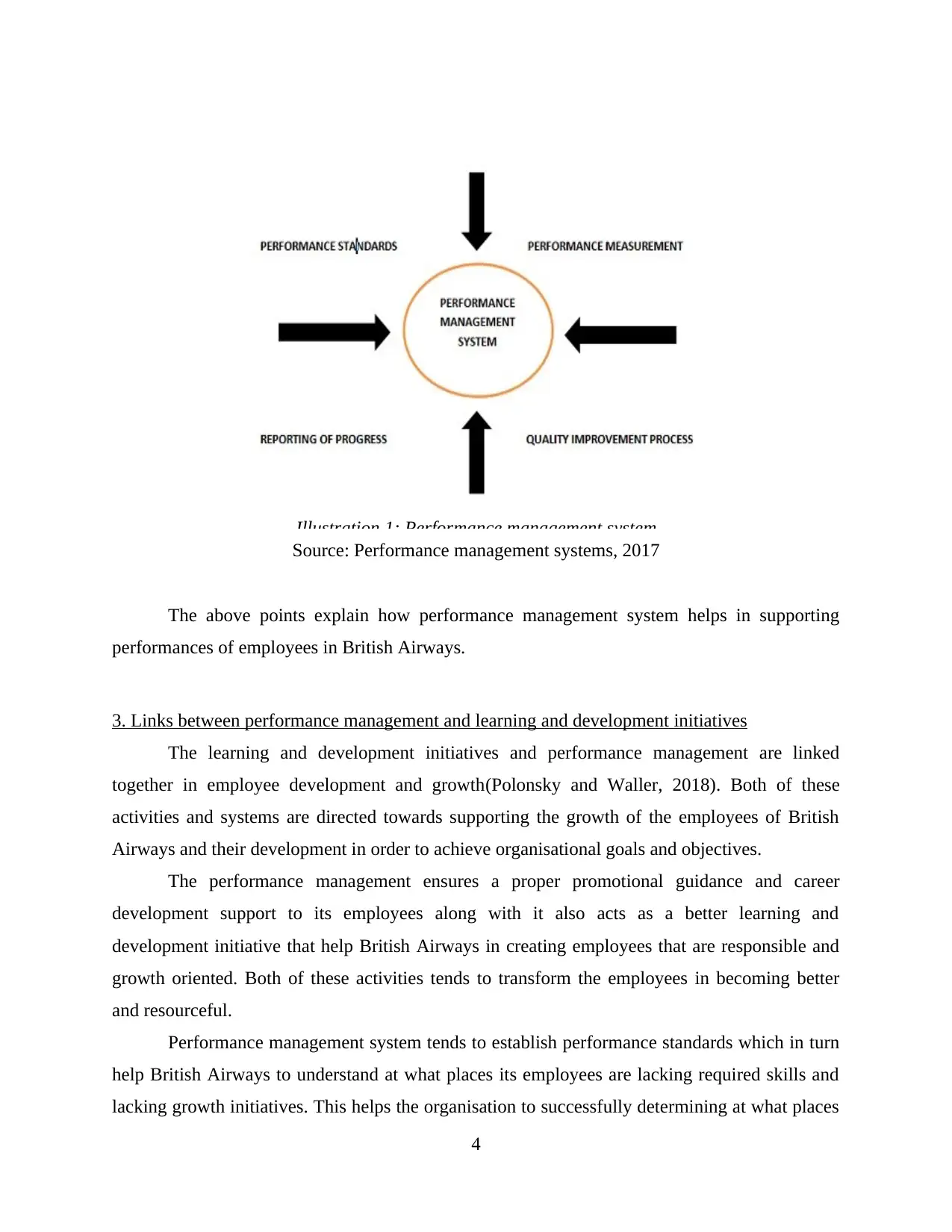
Source: Performance management systems, 2017
The above points explain how performance management system helps in supporting
performances of employees in British Airways.
3. Links between performance management and learning and development initiatives
The learning and development initiatives and performance management are linked
together in employee development and growth(Polonsky and Waller, 2018). Both of these
activities and systems are directed towards supporting the growth of the employees of British
Airways and their development in order to achieve organisational goals and objectives.
The performance management ensures a proper promotional guidance and career
development support to its employees along with it also acts as a better learning and
development initiative that help British Airways in creating employees that are responsible and
growth oriented. Both of these activities tends to transform the employees in becoming better
and resourceful.
Performance management system tends to establish performance standards which in turn
help British Airways to understand at what places its employees are lacking required skills and
lacking growth initiatives. This helps the organisation to successfully determining at what places
4
Illustration 1: Performance management system
The above points explain how performance management system helps in supporting
performances of employees in British Airways.
3. Links between performance management and learning and development initiatives
The learning and development initiatives and performance management are linked
together in employee development and growth(Polonsky and Waller, 2018). Both of these
activities and systems are directed towards supporting the growth of the employees of British
Airways and their development in order to achieve organisational goals and objectives.
The performance management ensures a proper promotional guidance and career
development support to its employees along with it also acts as a better learning and
development initiative that help British Airways in creating employees that are responsible and
growth oriented. Both of these activities tends to transform the employees in becoming better
and resourceful.
Performance management system tends to establish performance standards which in turn
help British Airways to understand at what places its employees are lacking required skills and
lacking growth initiatives. This helps the organisation to successfully determining at what places
4
Illustration 1: Performance management system
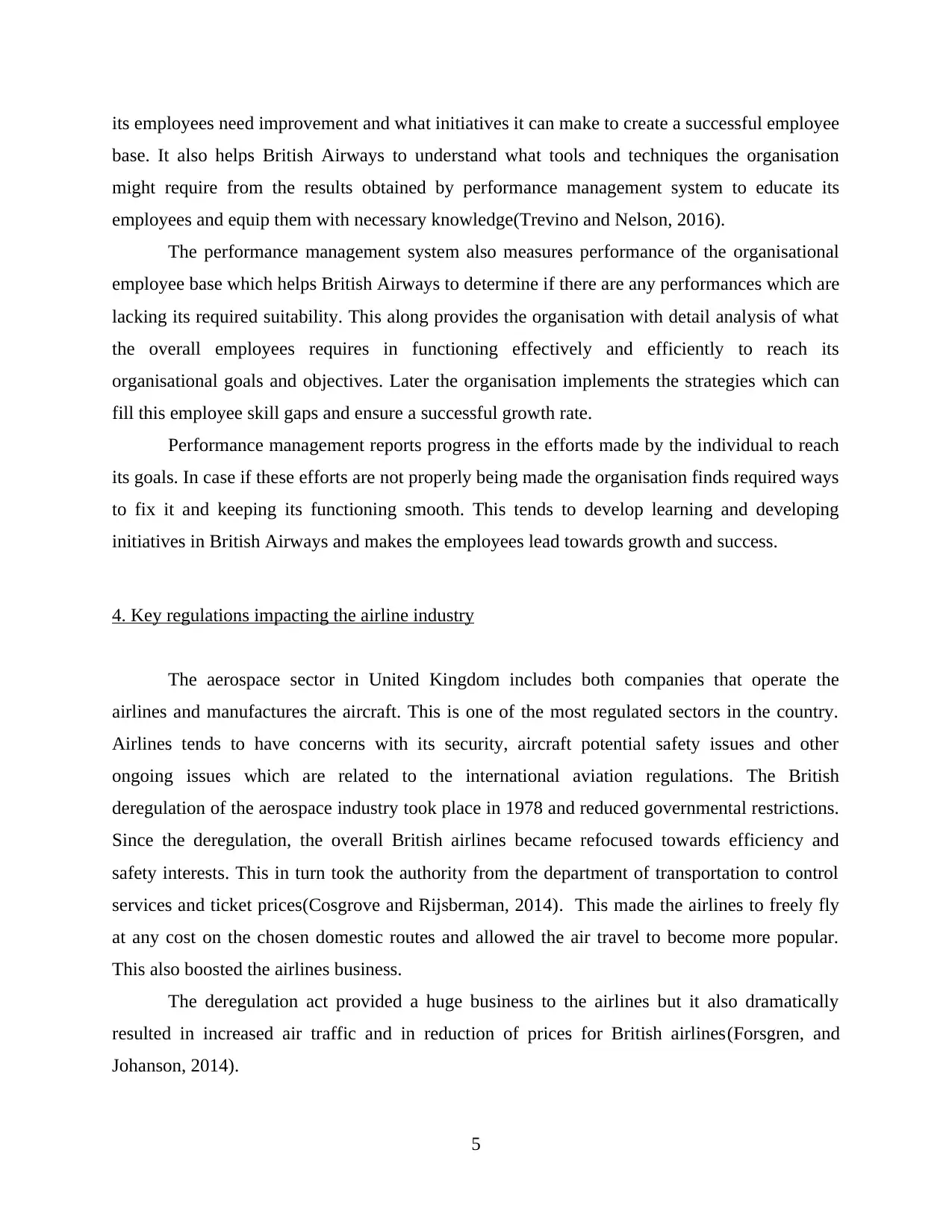
its employees need improvement and what initiatives it can make to create a successful employee
base. It also helps British Airways to understand what tools and techniques the organisation
might require from the results obtained by performance management system to educate its
employees and equip them with necessary knowledge(Trevino and Nelson, 2016).
The performance management system also measures performance of the organisational
employee base which helps British Airways to determine if there are any performances which are
lacking its required suitability. This along provides the organisation with detail analysis of what
the overall employees requires in functioning effectively and efficiently to reach its
organisational goals and objectives. Later the organisation implements the strategies which can
fill this employee skill gaps and ensure a successful growth rate.
Performance management reports progress in the efforts made by the individual to reach
its goals. In case if these efforts are not properly being made the organisation finds required ways
to fix it and keeping its functioning smooth. This tends to develop learning and developing
initiatives in British Airways and makes the employees lead towards growth and success.
4. Key regulations impacting the airline industry
The aerospace sector in United Kingdom includes both companies that operate the
airlines and manufactures the aircraft. This is one of the most regulated sectors in the country.
Airlines tends to have concerns with its security, aircraft potential safety issues and other
ongoing issues which are related to the international aviation regulations. The British
deregulation of the aerospace industry took place in 1978 and reduced governmental restrictions.
Since the deregulation, the overall British airlines became refocused towards efficiency and
safety interests. This in turn took the authority from the department of transportation to control
services and ticket prices(Cosgrove and Rijsberman, 2014). This made the airlines to freely fly
at any cost on the chosen domestic routes and allowed the air travel to become more popular.
This also boosted the airlines business.
The deregulation act provided a huge business to the airlines but it also dramatically
resulted in increased air traffic and in reduction of prices for British airlines(Forsgren, and
Johanson, 2014).
5
base. It also helps British Airways to understand what tools and techniques the organisation
might require from the results obtained by performance management system to educate its
employees and equip them with necessary knowledge(Trevino and Nelson, 2016).
The performance management system also measures performance of the organisational
employee base which helps British Airways to determine if there are any performances which are
lacking its required suitability. This along provides the organisation with detail analysis of what
the overall employees requires in functioning effectively and efficiently to reach its
organisational goals and objectives. Later the organisation implements the strategies which can
fill this employee skill gaps and ensure a successful growth rate.
Performance management reports progress in the efforts made by the individual to reach
its goals. In case if these efforts are not properly being made the organisation finds required ways
to fix it and keeping its functioning smooth. This tends to develop learning and developing
initiatives in British Airways and makes the employees lead towards growth and success.
4. Key regulations impacting the airline industry
The aerospace sector in United Kingdom includes both companies that operate the
airlines and manufactures the aircraft. This is one of the most regulated sectors in the country.
Airlines tends to have concerns with its security, aircraft potential safety issues and other
ongoing issues which are related to the international aviation regulations. The British
deregulation of the aerospace industry took place in 1978 and reduced governmental restrictions.
Since the deregulation, the overall British airlines became refocused towards efficiency and
safety interests. This in turn took the authority from the department of transportation to control
services and ticket prices(Cosgrove and Rijsberman, 2014). This made the airlines to freely fly
at any cost on the chosen domestic routes and allowed the air travel to become more popular.
This also boosted the airlines business.
The deregulation act provided a huge business to the airlines but it also dramatically
resulted in increased air traffic and in reduction of prices for British airlines(Forsgren, and
Johanson, 2014).
5
⊘ This is a preview!⊘
Do you want full access?
Subscribe today to unlock all pages.

Trusted by 1+ million students worldwide
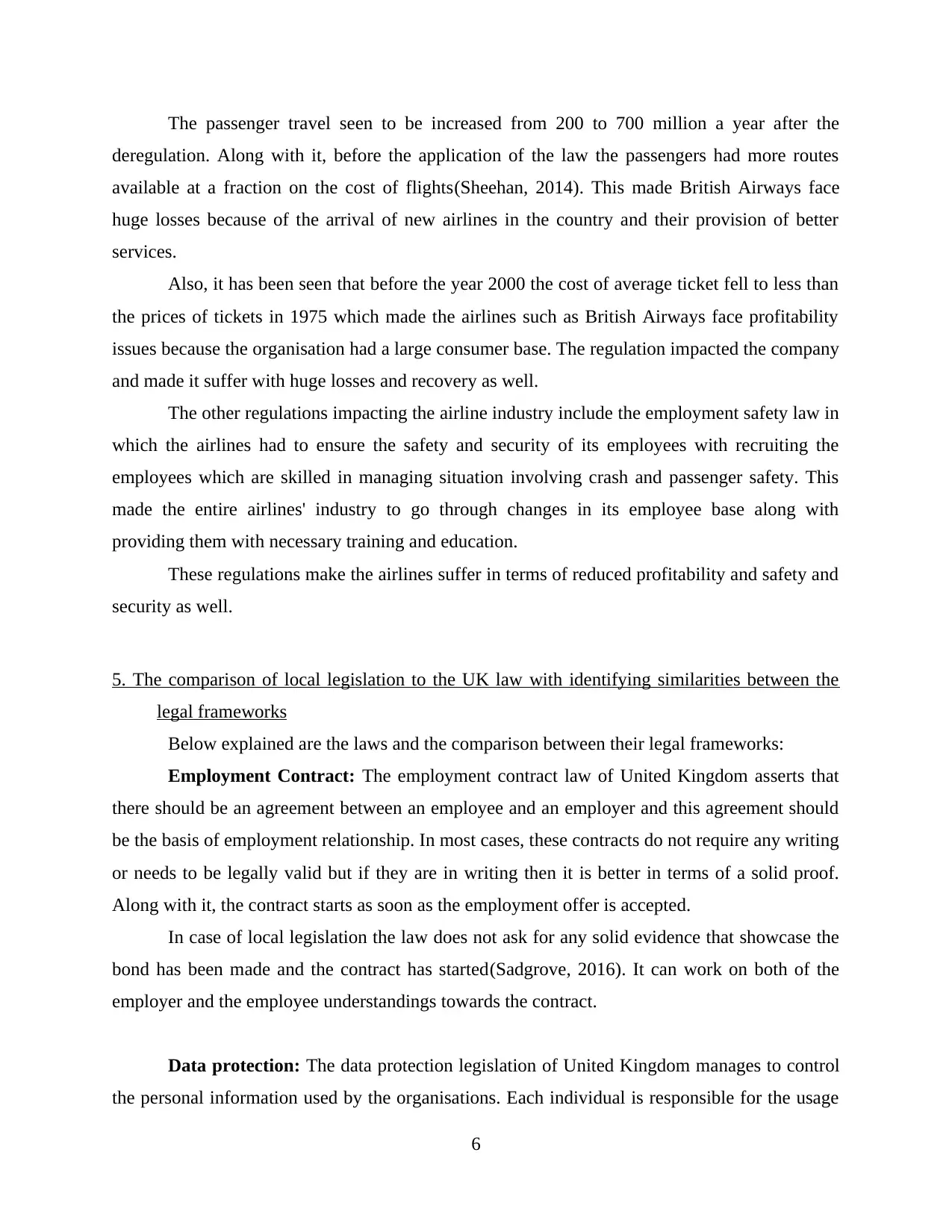
The passenger travel seen to be increased from 200 to 700 million a year after the
deregulation. Along with it, before the application of the law the passengers had more routes
available at a fraction on the cost of flights(Sheehan, 2014). This made British Airways face
huge losses because of the arrival of new airlines in the country and their provision of better
services.
Also, it has been seen that before the year 2000 the cost of average ticket fell to less than
the prices of tickets in 1975 which made the airlines such as British Airways face profitability
issues because the organisation had a large consumer base. The regulation impacted the company
and made it suffer with huge losses and recovery as well.
The other regulations impacting the airline industry include the employment safety law in
which the airlines had to ensure the safety and security of its employees with recruiting the
employees which are skilled in managing situation involving crash and passenger safety. This
made the entire airlines' industry to go through changes in its employee base along with
providing them with necessary training and education.
These regulations make the airlines suffer in terms of reduced profitability and safety and
security as well.
5. The comparison of local legislation to the UK law with identifying similarities between the
legal frameworks
Below explained are the laws and the comparison between their legal frameworks:
Employment Contract: The employment contract law of United Kingdom asserts that
there should be an agreement between an employee and an employer and this agreement should
be the basis of employment relationship. In most cases, these contracts do not require any writing
or needs to be legally valid but if they are in writing then it is better in terms of a solid proof.
Along with it, the contract starts as soon as the employment offer is accepted.
In case of local legislation the law does not ask for any solid evidence that showcase the
bond has been made and the contract has started(Sadgrove, 2016). It can work on both of the
employer and the employee understandings towards the contract.
Data protection: The data protection legislation of United Kingdom manages to control
the personal information used by the organisations. Each individual is responsible for the usage
6
deregulation. Along with it, before the application of the law the passengers had more routes
available at a fraction on the cost of flights(Sheehan, 2014). This made British Airways face
huge losses because of the arrival of new airlines in the country and their provision of better
services.
Also, it has been seen that before the year 2000 the cost of average ticket fell to less than
the prices of tickets in 1975 which made the airlines such as British Airways face profitability
issues because the organisation had a large consumer base. The regulation impacted the company
and made it suffer with huge losses and recovery as well.
The other regulations impacting the airline industry include the employment safety law in
which the airlines had to ensure the safety and security of its employees with recruiting the
employees which are skilled in managing situation involving crash and passenger safety. This
made the entire airlines' industry to go through changes in its employee base along with
providing them with necessary training and education.
These regulations make the airlines suffer in terms of reduced profitability and safety and
security as well.
5. The comparison of local legislation to the UK law with identifying similarities between the
legal frameworks
Below explained are the laws and the comparison between their legal frameworks:
Employment Contract: The employment contract law of United Kingdom asserts that
there should be an agreement between an employee and an employer and this agreement should
be the basis of employment relationship. In most cases, these contracts do not require any writing
or needs to be legally valid but if they are in writing then it is better in terms of a solid proof.
Along with it, the contract starts as soon as the employment offer is accepted.
In case of local legislation the law does not ask for any solid evidence that showcase the
bond has been made and the contract has started(Sadgrove, 2016). It can work on both of the
employer and the employee understandings towards the contract.
Data protection: The data protection legislation of United Kingdom manages to control
the personal information used by the organisations. Each individual is responsible for the usage
6
Paraphrase This Document
Need a fresh take? Get an instant paraphrase of this document with our AI Paraphraser
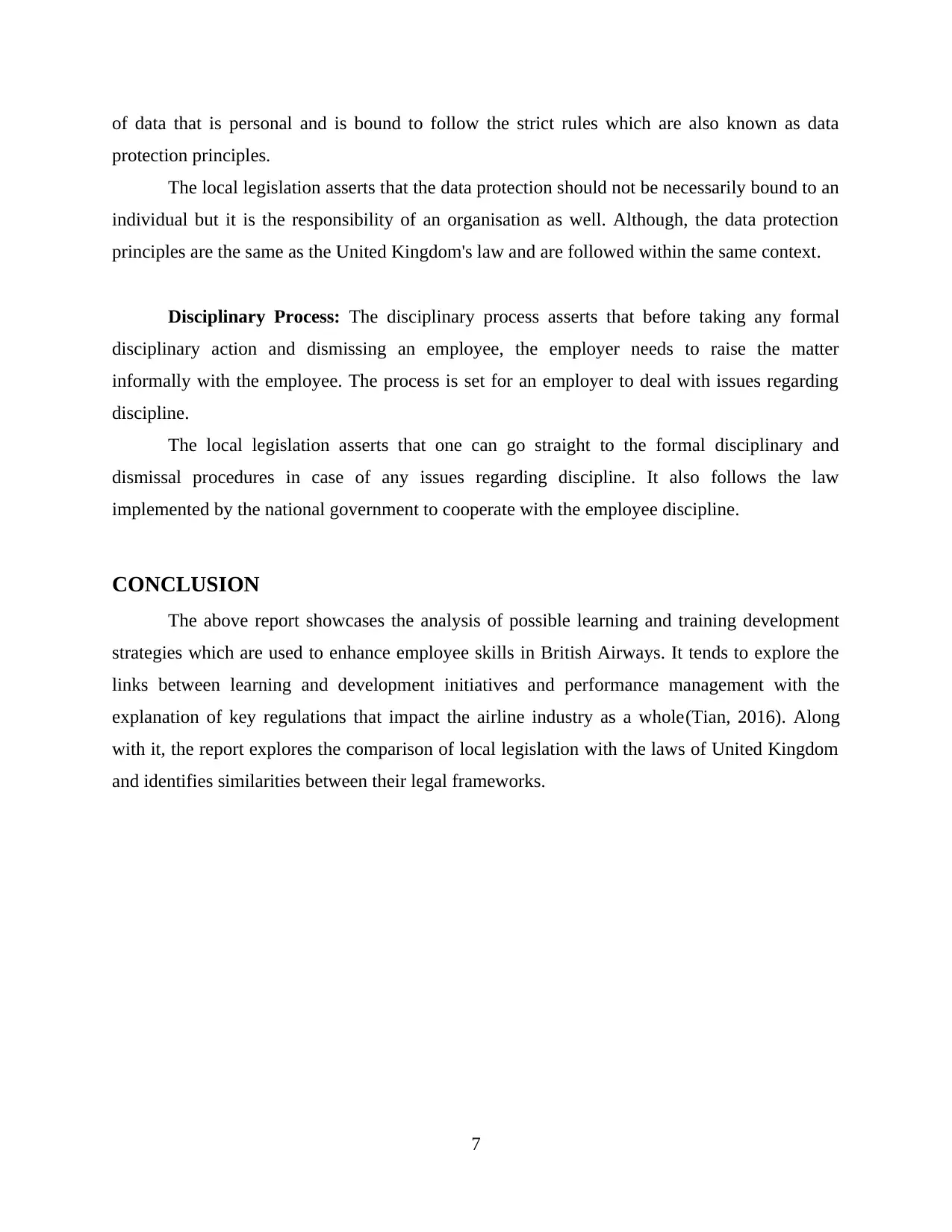
of data that is personal and is bound to follow the strict rules which are also known as data
protection principles.
The local legislation asserts that the data protection should not be necessarily bound to an
individual but it is the responsibility of an organisation as well. Although, the data protection
principles are the same as the United Kingdom's law and are followed within the same context.
Disciplinary Process: The disciplinary process asserts that before taking any formal
disciplinary action and dismissing an employee, the employer needs to raise the matter
informally with the employee. The process is set for an employer to deal with issues regarding
discipline.
The local legislation asserts that one can go straight to the formal disciplinary and
dismissal procedures in case of any issues regarding discipline. It also follows the law
implemented by the national government to cooperate with the employee discipline.
CONCLUSION
The above report showcases the analysis of possible learning and training development
strategies which are used to enhance employee skills in British Airways. It tends to explore the
links between learning and development initiatives and performance management with the
explanation of key regulations that impact the airline industry as a whole(Tian, 2016). Along
with it, the report explores the comparison of local legislation with the laws of United Kingdom
and identifies similarities between their legal frameworks.
7
protection principles.
The local legislation asserts that the data protection should not be necessarily bound to an
individual but it is the responsibility of an organisation as well. Although, the data protection
principles are the same as the United Kingdom's law and are followed within the same context.
Disciplinary Process: The disciplinary process asserts that before taking any formal
disciplinary action and dismissing an employee, the employer needs to raise the matter
informally with the employee. The process is set for an employer to deal with issues regarding
discipline.
The local legislation asserts that one can go straight to the formal disciplinary and
dismissal procedures in case of any issues regarding discipline. It also follows the law
implemented by the national government to cooperate with the employee discipline.
CONCLUSION
The above report showcases the analysis of possible learning and training development
strategies which are used to enhance employee skills in British Airways. It tends to explore the
links between learning and development initiatives and performance management with the
explanation of key regulations that impact the airline industry as a whole(Tian, 2016). Along
with it, the report explores the comparison of local legislation with the laws of United Kingdom
and identifies similarities between their legal frameworks.
7
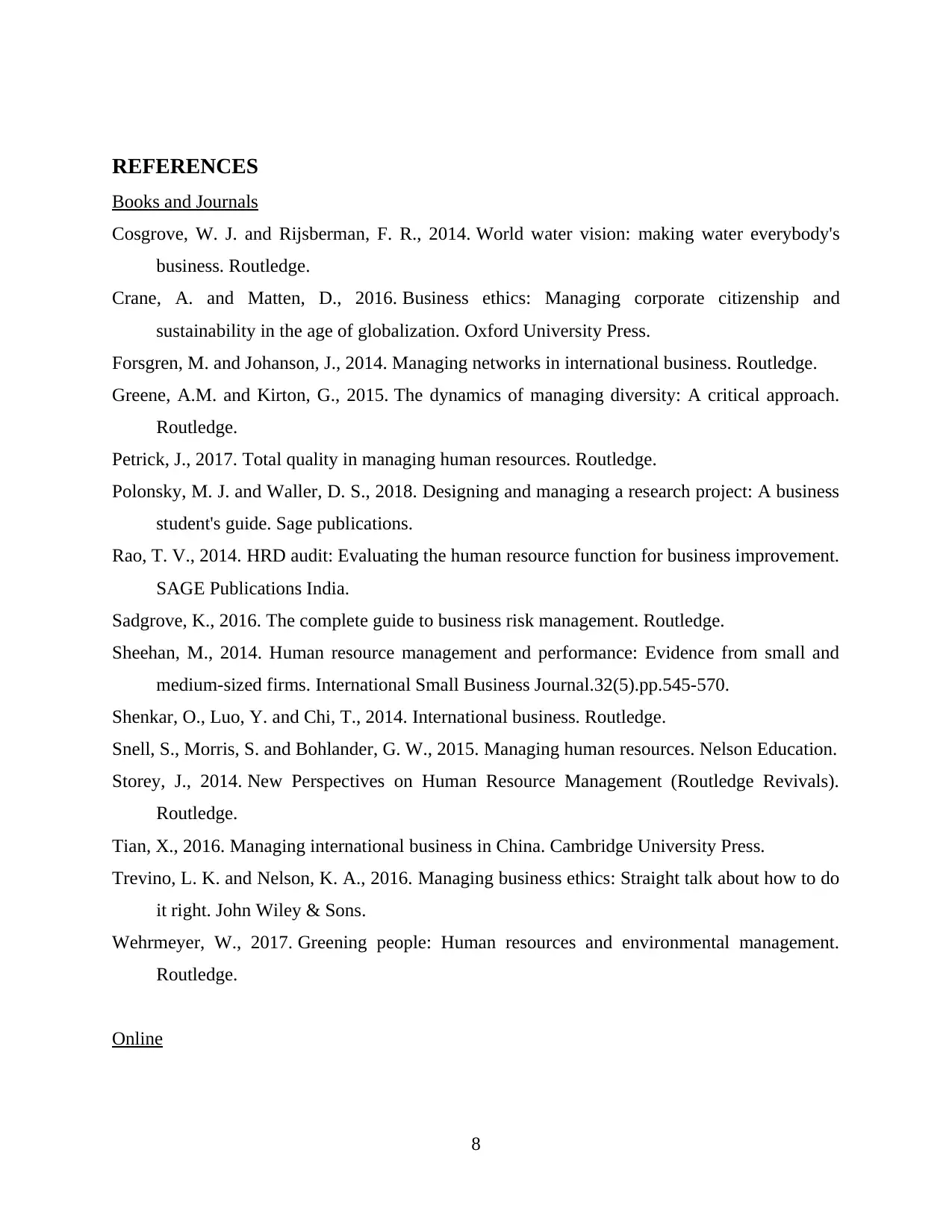
REFERENCES
Books and Journals
Cosgrove, W. J. and Rijsberman, F. R., 2014. World water vision: making water everybody's
business. Routledge.
Crane, A. and Matten, D., 2016. Business ethics: Managing corporate citizenship and
sustainability in the age of globalization. Oxford University Press.
Forsgren, M. and Johanson, J., 2014. Managing networks in international business. Routledge.
Greene, A.M. and Kirton, G., 2015. The dynamics of managing diversity: A critical approach.
Routledge.
Petrick, J., 2017. Total quality in managing human resources. Routledge.
Polonsky, M. J. and Waller, D. S., 2018. Designing and managing a research project: A business
student's guide. Sage publications.
Rao, T. V., 2014. HRD audit: Evaluating the human resource function for business improvement.
SAGE Publications India.
Sadgrove, K., 2016. The complete guide to business risk management. Routledge.
Sheehan, M., 2014. Human resource management and performance: Evidence from small and
medium-sized firms. International Small Business Journal.32(5).pp.545-570.
Shenkar, O., Luo, Y. and Chi, T., 2014. International business. Routledge.
Snell, S., Morris, S. and Bohlander, G. W., 2015. Managing human resources. Nelson Education.
Storey, J., 2014. New Perspectives on Human Resource Management (Routledge Revivals).
Routledge.
Tian, X., 2016. Managing international business in China. Cambridge University Press.
Trevino, L. K. and Nelson, K. A., 2016. Managing business ethics: Straight talk about how to do
it right. John Wiley & Sons.
Wehrmeyer, W., 2017. Greening people: Human resources and environmental management.
Routledge.
Online
8
Books and Journals
Cosgrove, W. J. and Rijsberman, F. R., 2014. World water vision: making water everybody's
business. Routledge.
Crane, A. and Matten, D., 2016. Business ethics: Managing corporate citizenship and
sustainability in the age of globalization. Oxford University Press.
Forsgren, M. and Johanson, J., 2014. Managing networks in international business. Routledge.
Greene, A.M. and Kirton, G., 2015. The dynamics of managing diversity: A critical approach.
Routledge.
Petrick, J., 2017. Total quality in managing human resources. Routledge.
Polonsky, M. J. and Waller, D. S., 2018. Designing and managing a research project: A business
student's guide. Sage publications.
Rao, T. V., 2014. HRD audit: Evaluating the human resource function for business improvement.
SAGE Publications India.
Sadgrove, K., 2016. The complete guide to business risk management. Routledge.
Sheehan, M., 2014. Human resource management and performance: Evidence from small and
medium-sized firms. International Small Business Journal.32(5).pp.545-570.
Shenkar, O., Luo, Y. and Chi, T., 2014. International business. Routledge.
Snell, S., Morris, S. and Bohlander, G. W., 2015. Managing human resources. Nelson Education.
Storey, J., 2014. New Perspectives on Human Resource Management (Routledge Revivals).
Routledge.
Tian, X., 2016. Managing international business in China. Cambridge University Press.
Trevino, L. K. and Nelson, K. A., 2016. Managing business ethics: Straight talk about how to do
it right. John Wiley & Sons.
Wehrmeyer, W., 2017. Greening people: Human resources and environmental management.
Routledge.
Online
8
⊘ This is a preview!⊘
Do you want full access?
Subscribe today to unlock all pages.

Trusted by 1+ million students worldwide
1 out of 13
Related Documents
Your All-in-One AI-Powered Toolkit for Academic Success.
+13062052269
info@desklib.com
Available 24*7 on WhatsApp / Email
![[object Object]](/_next/static/media/star-bottom.7253800d.svg)
Unlock your academic potential
Copyright © 2020–2025 A2Z Services. All Rights Reserved. Developed and managed by ZUCOL.



